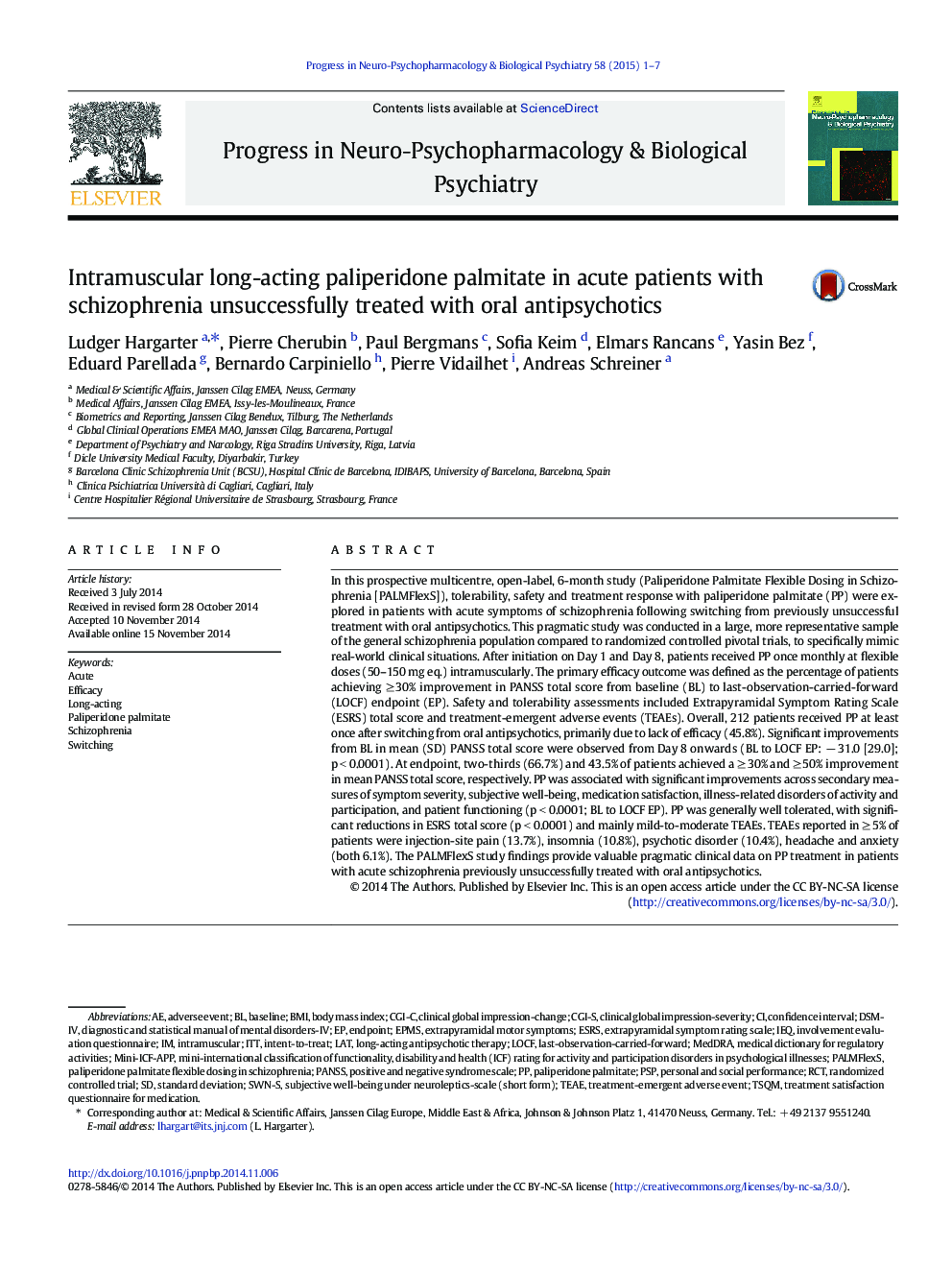| کد مقاله | کد نشریه | سال انتشار | مقاله انگلیسی | نسخه تمام متن |
|---|---|---|---|---|
| 5844364 | 1561036 | 2015 | 7 صفحه PDF | دانلود رایگان |
عنوان انگلیسی مقاله ISI
Intramuscular long-acting paliperidone palmitate in acute patients with schizophrenia unsuccessfully treated with oral antipsychotics
ترجمه فارسی عنوان
پالمیتات پالپیریدون طولانی مدت در بیماران مبتلا به اسکیزوفرنی با موفقیت درمان با داروهای ضد صرع خوراکی
دانلود مقاله + سفارش ترجمه
دانلود مقاله ISI انگلیسی
رایگان برای ایرانیان
کلمات کلیدی
MedDRAExtrapyramidal Symptom Rating ScaleESRSLast-observation-carried-forwardIEQpaliperidone palmitateclinical global impression-severityDiagnostic and Statistical Manual of Mental Disorders-IVLOCFPersonal and Social PerformanceCGI-SRCTCGI-CPANSSDSM-IVPSPRandomized controlled trial - آزمایش تصادفی کنترل شدهstandard deviation - انحراف معیارITT - اینجاbaseline - خط مقدمMedical Dictionary for Regulatory Activities - دیکشنری پزشکی برای فعالیت های نظارتیLAT - سالbody mass index - شاخص توده بدنBMI - شاخص توده بدنیadverse event - عارضه جانبی یا عوارض جانبیIntramuscular - عضلانیconfidence interval - فاصله اطمینانIntent-to-treat - قصد درمانpositive and negative syndrome scale - مقیاس مثبت و منفی سندرمEndpoint - نقطه پایانی
موضوعات مرتبط
علوم زیستی و بیوفناوری
علم عصب شناسی
روانپزشکی بیولوژیکی
چکیده انگلیسی
In this prospective multicentre, open-label, 6-month study (Paliperidone Palmitate Flexible Dosing in Schizophrenia [PALMFlexS]), tolerability, safety and treatment response with paliperidone palmitate (PP) were explored in patients with acute symptoms of schizophrenia following switching from previously unsuccessful treatment with oral antipsychotics. This pragmatic study was conducted in a large, more representative sample of the general schizophrenia population compared to randomized controlled pivotal trials, to specifically mimic real-world clinical situations. After initiation on Day 1 and Day 8, patients received PP once monthly at flexible doses (50-150 mg eq.) intramuscularly. The primary efficacy outcome was defined as the percentage of patients achieving â¥Â 30% improvement in PANSS total score from baseline (BL) to last-observation-carried-forward (LOCF) endpoint (EP). Safety and tolerability assessments included Extrapyramidal Symptom Rating Scale (ESRS) total score and treatment-emergent adverse events (TEAEs). Overall, 212 patients received PP at least once after switching from oral antipsychotics, primarily due to lack of efficacy (45.8%). Significant improvements from BL in mean (SD) PANSS total score were observed from Day 8 onwards (BL to LOCF EP: â 31.0 [29.0]; p < 0.0001). At endpoint, two-thirds (66.7%) and 43.5% of patients achieved a â¥Â 30% and â¥Â 50% improvement in mean PANSS total score, respectively. PP was associated with significant improvements across secondary measures of symptom severity, subjective well-being, medication satisfaction, illness-related disorders of activity and participation, and patient functioning (p < 0.0001; BL to LOCF EP). PP was generally well tolerated, with significant reductions in ESRS total score (p < 0.0001) and mainly mild-to-moderate TEAEs. TEAEs reported in â¥Â 5% of patients were injection-site pain (13.7%), insomnia (10.8%), psychotic disorder (10.4%), headache and anxiety (both 6.1%). The PALMFlexS study findings provide valuable pragmatic clinical data on PP treatment in patients with acute schizophrenia previously unsuccessfully treated with oral antipsychotics.
ناشر
Database: Elsevier - ScienceDirect (ساینس دایرکت)
Journal: Progress in Neuro-Psychopharmacology and Biological Psychiatry - Volume 58, 3 April 2015, Pages 1-7
Journal: Progress in Neuro-Psychopharmacology and Biological Psychiatry - Volume 58, 3 April 2015, Pages 1-7
نویسندگان
Ludger Hargarter, Pierre Cherubin, Paul Bergmans, Sofia Keim, Elmars Rancans, Yasin Bez, Eduard Parellada, Bernardo Carpiniello, Pierre Vidailhet, Andreas Schreiner,
